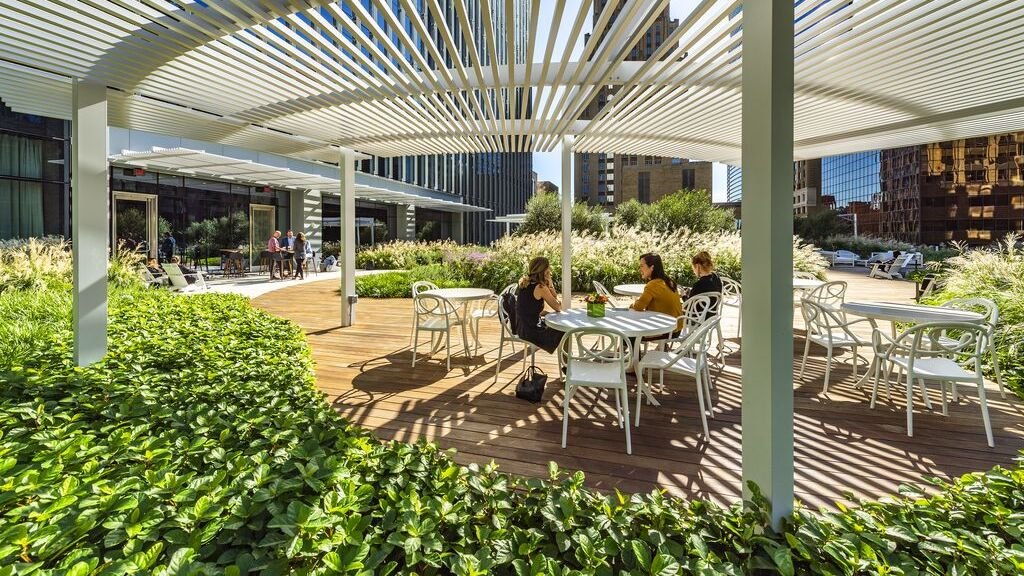Putting People at the Center to Drive Value for Real Estate | Defining ‘S’ in Six Targeted Outcomes
The business of real estate has always been about responding to the prevailing needs of society at the time. Today, investor demand, increased regulations, and rising material risk due to climate change continue to fuel ESG’s growth, but many details about implementation and reporting remain unresolved, particularly for the ‘S’ in ESG.
Setting the Social Standard Through ‘S’ Data
Fitwel is developing a new social solution that takes certified data and validated research, to elevate the evident connections between health, the environment, and underlying value. This revolutionary new product will provide a clear, consistent, actionable framework for the global investing community to demonstrate their role in achieving value through the ‘S’ in ESG.
We’re changing the ESG landscape.
Fitwel is collaborating with EVORA Global to launch the industry’s first product aimed at standardizing and benchmarking the social component of ESG in real estate globally. The tool will, for the first time, overlay financial value with health outcomes, pointing to clear substantiation of value and risk for real estate.
The groundbreaking product will provide data insights, support compliance and ESG reporting submissions in accordance with global reporting standards-setting organizations like GRESB, SASB, the EU Taxonomy, and others, and enable standardized real estate industry performance rankings when it comes to ‘S’.
How did we get here?
Over the last two years, we've researched the economic impacts of the Fitwel Standard and created a subset of strategies that have the greatest impact on health, material risk, and financial value. The Center for Active Design (CfAD) identified Six Targeted Outcomes using Five Economic Impact Categories after a year-long exploration that connects health-promoting goals with economic value creation.
5 Economic Impact Categories
We know the proven impact of Fitwel strategies on health, but how does that impact translate to financial outcomes?The Center for Active Design’s year-long analysis assessed the Fitwel strategy library against the following economic impacts. A subset of strategies with the highest assessed impacts are included in our new social solution.
Increased ROI
Reduced Risk Exposure
Employee Productivity
Reduced On-Site Costs
Increased Tenant Satisfaction
Defining ‘S’ in Six Targeted Outcomes
At the outset of product development, we structured our new social solution around six targeted outcomes that capture the most meaningful overlaps between ESG reporting and health and well-being in real estate.
For the remaining 3 Targeted Outcomes and additional insights, please complete the form below to download your copy of Building Health Issue #2, Expanding the Evidence. By signing up, you'll receive exclusive updates and priority access to future Building Health issues.
“Targeted Outcomes” Sources
Alfonzo, M. (2015). Making the Economic Case for More Walkability. Urban Land Institute. Retrieved from https://urbanland. uli.org/public/houston-economic-case-walkability.
Donovan, G. H., Landry, S., & Winter, C. (2019). Urban trees, house price, and redevelopment pressure in Tampa, Florida. Urban Forestry & Urban Greening, 38, 330-336.3.
Cooper, R. A., Wang, C., & Singh, N. (2016). Evaluation of a model community-wide bed bug management program in affordable housing. Pest Manag Sci, 72(1), 45-56.4.
Search Blog Articles
By Category
- Adai News
- Best in Building Health
- Certification
- Conferences
- ESG
- Featured
- Fitwel Ambassadors
- Fitwel Champions
- Fitwel Platform
- Fitwel Providers & Partners
- From the CEO
- Healthy Building Profiles
- Podcasts
- Press & Media
- Publications & Reports
- Research Insights
- Strategies & Solutions
- Viral Response Module
- Webinars
By Month
- December 2025
- November 2025
- October 2025
- September 2025
- July 2025
- May 2025
- April 2025
- March 2025
- February 2025
- January 2025
- December 2024
- November 2024
- October 2024
- September 2024
- August 2024
- July 2024
- June 2024
- May 2024
- April 2024
- March 2024
- February 2024
- January 2024
- December 2023
- November 2023
- October 2023
- September 2023
- August 2023
- July 2023
- June 2023
- May 2023
- April 2023
- March 2023
- February 2023
- January 2023
- December 2022
- November 2022
- October 2022
- September 2022
- June 2022
- May 2022
- April 2022
- March 2022
- February 2022
- January 2022
- December 2021
- May 2021
- April 2021
- March 2021
- October 2020
- July 2020
- May 2020
- April 2020



